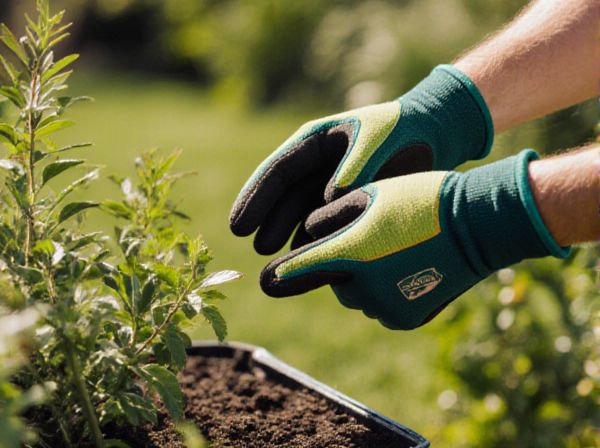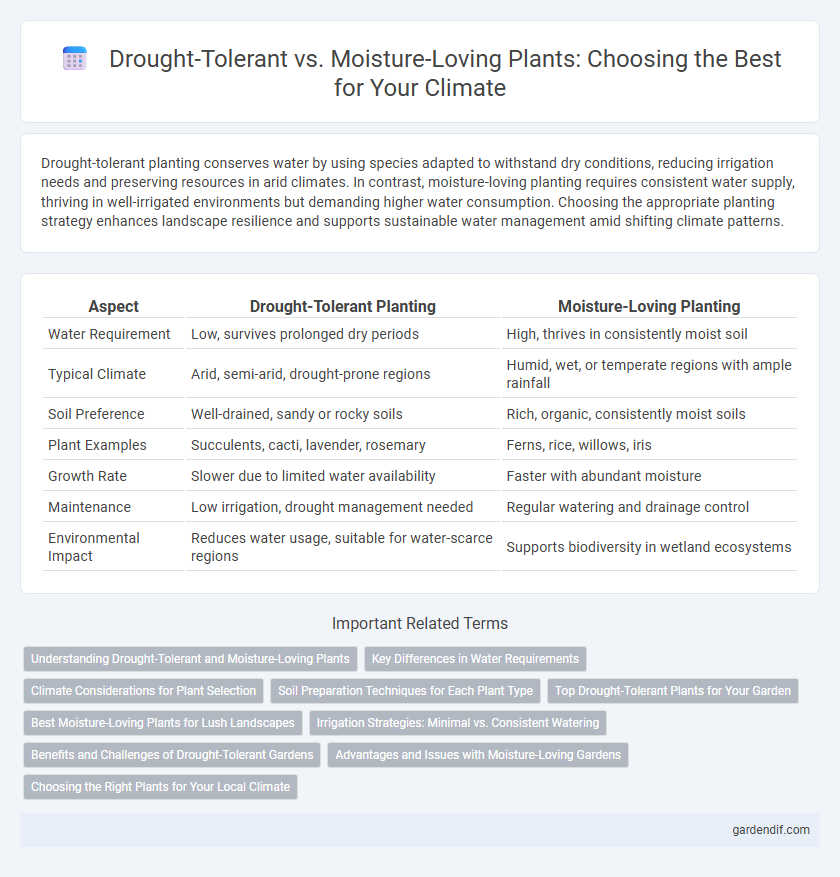
Drought-tolerant planting vs Moisture-loving planting Illustration
Drought-tolerant planting conserves water by using species adapted to withstand dry conditions, reducing irrigation needs and preserving resources in arid climates. In contrast, moisture-loving planting requires consistent water supply, thriving in well-irrigated environments but demanding higher water consumption. Choosing the appropriate planting strategy enhances landscape resilience and supports sustainable water management amid shifting climate patterns.
Table of Comparison
| Aspect | Drought-Tolerant Planting | Moisture-Loving Planting |
|---|---|---|
| Water Requirement | Low, survives prolonged dry periods | High, thrives in consistently moist soil |
| Typical Climate | Arid, semi-arid, drought-prone regions | Humid, wet, or temperate regions with ample rainfall |
| Soil Preference | Well-drained, sandy or rocky soils | Rich, organic, consistently moist soils |
| Plant Examples | Succulents, cacti, lavender, rosemary | Ferns, rice, willows, iris |
| Growth Rate | Slower due to limited water availability | Faster with abundant moisture |
| Maintenance | Low irrigation, drought management needed | Regular watering and drainage control |
| Environmental Impact | Reduces water usage, suitable for water-scarce regions | Supports biodiversity in wetland ecosystems |
Understanding Drought-Tolerant and Moisture-Loving Plants
Drought-tolerant plants possess deep root systems and waxy leaves that reduce water loss, enabling survival in arid conditions with minimal irrigation. Moisture-loving plants thrive in consistently wet soils, requiring high humidity and regular watering to maintain growth and prevent stress. Selecting appropriate plants based on their water needs optimizes landscape resilience and conserves water resources amid climate variability.
Key Differences in Water Requirements
Drought-tolerant planting requires minimal water, adapting to arid conditions by efficiently using limited moisture and often thriving in well-drained soils. Moisture-loving planting demands consistent, abundant water supply, preferring environments with high humidity or frequent rainfall to maintain soil saturation. These contrasting water requirements significantly influence irrigation practices and plant selection in sustainable landscaping and agriculture.
Climate Considerations for Plant Selection
Drought-tolerant planting involves selecting species such as succulents, native grasses, and xerophytes that thrive in arid conditions with minimal water, reducing irrigation needs and conserving water resources. Moisture-loving plants, including ferns, hostas, and tropical species, require consistently high soil moisture and perform best in humid climates or areas with frequent rainfall. Climate considerations for plant selection prioritize local precipitation patterns, soil moisture retention, and temperature fluctuations to ensure sustainable growth and resilience against drought or excessive wetness.
Soil Preparation Techniques for Each Plant Type
Drought-tolerant planting requires soil preparation techniques that emphasize deep loosening and the addition of organic mulch to improve moisture retention while minimizing water evaporation. In contrast, moisture-loving planting benefits from soil enriched with compost and frequent aeration to maintain high water-holding capacity and nutrient availability. Tailoring soil amendments and preparation methods to the specific water needs of each plant type enhances growth efficiency and resilience under varying climate conditions.
Top Drought-Tolerant Plants for Your Garden
Top drought-tolerant plants such as lavender, succulents, and agave thrive in low-water environments by storing moisture and minimizing water loss. These species reduce irrigation needs while maintaining vibrant garden aesthetics, making them ideal for xeriscaping and areas prone to water scarcity. Incorporating drought-resistant plants leads to sustainable landscaping that conserves water resources and adapts to changing climate conditions.
Best Moisture-Loving Plants for Lush Landscapes
Moisture-loving plants such as ferns, hostas, and astilbes thrive in consistently damp soil, creating lush and vibrant landscapes. These species absorb and retain water efficiently, promoting healthy growth in wet or shaded environments. Selecting native moisture-loving plants enhances ecosystem resilience and supports local biodiversity in irrigated garden settings.
Irrigation Strategies: Minimal vs. Consistent Watering
Drought-tolerant planting thrives with minimal irrigation, relying on deep-root systems to maximize water absorption and reduce evaporation, which conserves water during dry spells. Moisture-loving planting requires consistent watering to maintain soil saturation, promoting healthy growth but increasing water usage and demand on irrigation infrastructure. Implementing drip irrigation for drought-tolerant species optimizes water efficiency, while moisture-loving plants benefit from scheduled sprinkler systems to ensure uniform moisture distribution.
Benefits and Challenges of Drought-Tolerant Gardens
Drought-tolerant gardens conserve water by using plants adapted to arid conditions, reducing irrigation needs and supporting sustainable landscaping. These plants enhance soil health and require less maintenance, but can face challenges like slower growth rates and limited species diversity compared to moisture-loving plants. Despite these challenges, drought-tolerant gardens contribute significantly to resilience against climate change and help mitigate water scarcity issues.
Advantages and Issues with Moisture-Loving Gardens
Moisture-loving gardens thrive in consistently wet environments, supporting diverse plant species that require abundant water, enhancing biodiversity and providing natural cooling through evaporation. However, these gardens demand high water input, increasing resource consumption and potentially straining local water supplies, especially in drought-prone regions. Excess moisture can also promote fungal diseases and root rot, requiring vigilant management to maintain plant health and garden sustainability.
Choosing the Right Plants for Your Local Climate
Selecting drought-tolerant plants such as succulents, lavender, and native grasses reduces water consumption and thrives in arid, high-temperature regions. Moisture-loving plants like ferns, hostas, and water lilies require consistently damp soil and are suited for humid, shaded environments with frequent rainfall. Matching plant species to local climate conditions ensures sustainable gardening, conserves water resources, and supports ecosystem resilience.
Drought-tolerant planting vs Moisture-loving planting Infographic

 gardendif.com
gardendif.com